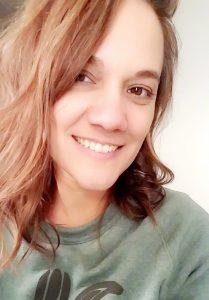Writers@Work: An Interview with J. Mercer
May 22, 2018
Note From Rochelle
Dear Readers,
Today, I am delighted to welcome author J. Mercer to talk about her brand new book, After They Go and give you some tips on plotting. Pro Tip: Buy the book. It features great characters in an idyllic setting with lots of drama and a bit of romance.
Enjoy!
Rochelle

Writers@Work:
An Interview with J. Mercer
by Rochelle Melander
Tell us a bit about your new novel, After They Go.
 Hi Rochelle! Thanks for having me 🙂 After They Go is a large family saga set in a coastal tourist town. Really, it’s about sisters and life and what you expect versus what you sometimes end up with. One early reader eloquently described it as this: “The story follows one family on the brink of financial ruin in a coastal vacation town. It is a place of contradictions—homey and inviting for some, a stifling source of tradition and responsibility for others. What I found most engrossing was the story’s central characters: three sisters and their mother. Like the town, they are full of contradictions: self-absorbed and self-sacrificing, reckless and wise. They are flawed and hurting, every one—keeping secrets, nursing grudges, indulging their obsessions. Through it all, their love for each other is like the flame that both guides and sears them. It is the engine behind their actions as well as the source of their greatest limitations. After They Go explores how the people we love most can both help and hinder us on the journey to become our true selves. An absorbing read!”
Hi Rochelle! Thanks for having me 🙂 After They Go is a large family saga set in a coastal tourist town. Really, it’s about sisters and life and what you expect versus what you sometimes end up with. One early reader eloquently described it as this: “The story follows one family on the brink of financial ruin in a coastal vacation town. It is a place of contradictions—homey and inviting for some, a stifling source of tradition and responsibility for others. What I found most engrossing was the story’s central characters: three sisters and their mother. Like the town, they are full of contradictions: self-absorbed and self-sacrificing, reckless and wise. They are flawed and hurting, every one—keeping secrets, nursing grudges, indulging their obsessions. Through it all, their love for each other is like the flame that both guides and sears them. It is the engine behind their actions as well as the source of their greatest limitations. After They Go explores how the people we love most can both help and hinder us on the journey to become our true selves. An absorbing read!”
I know you lead plotting workshops. Do you have any tools or techniques to help new writers learn how to plot?
I do! I really love breaking things apart and seeing how they work, and have come up with some plot prompts to help writers think more deeply about their story and how the emotional and dramatic lines intersect. I have a plot graph I encourage writers to use as a revision tool – to easily illustrate where their plot gaps and where/what they might need to add in the second or third round, and some tables to help in pre-draft planning, but the technique that’s most easily shared in this format would be to think of your plot as building a case.
The setup is generally easy, and the climax might come to you more intuitively, the mid-point crisis sometimes sags but there’s a lot of talk about that. Inciting incident, too, is covered a lot, but what about all the in-between? The places that can slow the pace or seem like a strange jump from one point to the next. I’d encourage authors to think about what proof they need to drop in those spaces to make the climax work believably. So when the reader gets there, all the bits have been laid out and it all comes together. The goal being unexpected inevitability, where the reader thinks “I didn’t see that coming, but now it’s happened, it makes so much sense—nothing else *could* have happened.”
Also, cause and effect! That would be my takeaway—your jumping off point—think “if this happened, what would this character (or that character) be compelled to do?” Then think of the case you’re building. I know, you’ve heard cause and effect before, but you need to get inside that scene and think of the next logistical outcome. And maybe the happenstance hits elsewhere, to someone or something not in that scene, who would have a reaction—then go there next. That counts too!
For readers who have already written a novel, what tips do you have for spotting plot problems?
Back to the plot graph. You can find various versions of this online, but mainly what you want is a table/graph with your emotional plot, dramatic plot, and other subplots down the left side. Then your chapters along the top. Read or scan through your manuscript, checking off where those plots/subplots hit in which chapters. Then you can step back and see if there’s a subplot you forgot about for five chapters or one you dropped altogether. A good chapter will hit on more than one at a time, unless perhaps you’re writing in very short chapters. If you’re the organized type, you might want to take this a step further and highlight where the main plot points hit on the graph, to see that they all fall about the same time in your story for every subplot (Often your climax – and other main plot points – will cover all of the subplots in one scene, or most). This graphed vantage will give you a solid overview of the big changes needed going back in, and seeing it all mapped on one or two pages allows you to step back and see the mechanics of the whole novel at once—how it’s working together—rather than being a nose length away and having trouble seeing ten pages in front of you.
As an editor and an expert at revising your own novels, what advice do you give people about revising big things—like plot problems or character issues?
Definitely tackle those bigger things first. Do *not* get bogged down in line edits and small changes that you might delete anyway, once you realize you have bigger fish to fry. The traditional publishing world does it this way, too, for good reason! Be smart and efficient, and you’ll feel less like you’re beating your head against a wall. Plot problems, I think, need to be seen big picture, thus where the plot graph comes in. To be able to pluck at it and make it work, you need that overall vantage, and it helps clear the clouds. Character issues often come to light once you have that plot ironed out—because then the character strengths and weaknesses you started with don’t always work with the new plot and you might need to tweak them. So my advice here would be to write a messy draft, step back and look at the plot, then adjust the characters to further enhance and deepen the plot. Working together, plot and characterization really highlight each other and make magic 🙂
Also, a final note on characters (and tying them to cause and effect) is that they must propel the story 75-95% of the time. The antagonist can do some lifting here too, but your protagonist needs to do things that cause an effect. If they do things or make choices where you can’t see where they’d go next in direct relation to what just happened, then you’re connecting a bunch of happenstance and that doesn’t make for a page turner. You might need to adjust the plot or their characterization so you can see what their next step would be, and once you get that right, it should be pretty intuitive.
Also, if you’re having trouble filling out your side characters, think about how they could personify the protagonists inner struggle, or illustrate where the protagonist needs to end up. That might help give them something to do, a goal that would help you write them.
What are you reading now?
Beneath the Haunting Sea by Joanna Meyer, and Vanishing Girls by Lauren Oliver. My WIP is a young adult fantasy—though my next release will be YA contemporary—so I’m reading a lot of fantasy right now.
And where can readers or authors go for more information?
All updates and news will be on my Facebook page @jmercerbooks, and more info on my workshop and editing services are on my website: www.jmercerbooks.com.
Thanks so much for having me, Rochelle! Happy reading and writing and revising, everyone!
 About the author. J Mercer grew up in Wisconsin where she walked home from school with her head in a book, filled notebooks with stories in junior high, then went to UW Madison for accounting and psychology only to open a dog daycare. She wishes she were an expert linguist, is pretty much a professional with regards to competitive dance hair (bunhawk, anyone?), and enjoys exploring with her husband—though as much as she loves to travel, she’s also an accomplished hermit. Perfect days include cancelled plans, rain, and endless hours to do with what she pleases.
About the author. J Mercer grew up in Wisconsin where she walked home from school with her head in a book, filled notebooks with stories in junior high, then went to UW Madison for accounting and psychology only to open a dog daycare. She wishes she were an expert linguist, is pretty much a professional with regards to competitive dance hair (bunhawk, anyone?), and enjoys exploring with her husband—though as much as she loves to travel, she’s also an accomplished hermit. Perfect days include cancelled plans, rain, and endless hours to do with what she pleases.









Thanks for having me, Rochelle!